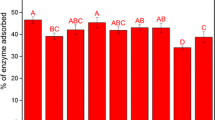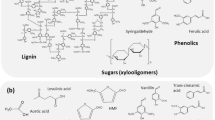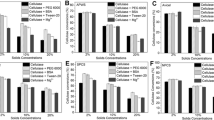Abstract
Pretreatment of corn stover with alkaline peroxide (AP) at pH 11.5 resulted in reduction of lignin content in the residual solids as a function of increasing batch temperature. Scanning electron microscopy of these materials revealed notably more textured surfaces on the plant cell walls as a result of the delignifying pretreatment. As expected, digestion of the delignified samples with commercial cellulase preparations showed an inverse relationship between the content of lignin present in the residual solids after pretreatment and the extent of both glucan and xylan conversion achievable. Digestions with purified enzymes revealed that decreased lignin content in the pretreated solids did not significantly impact the extent of glucan conversion achievable by cellulases alone. Not until purified xylanolytic activities were included with the cellulases were significant improvements in glucan conversion realized. In addition, an inverse relationship was observed between lignin content after pretreatment and the extent of xylan conversion achievable in a 24-h period with the xylanolytic enzymes in the absence of the cellulases. This observation, coupled with the direct relationship between enzymatic xylan and glucan conversion observed in a number of cases, suggests that the presence of lignins may not directly occlude cellulose present in lignocelluloses but rather impact cellulase action indirectly by its association with xylan.





Similar content being viewed by others
References
Kohlmann, K. L., et al. (1996). Advances in Space Research, 18, 251–265. doi:10.1016/0273-1177(95)00815-V.
Zhang, Y. H., & Lynd, L. R. (2006). Biotechnology and Bioengineering, 94, 888–898. doi:10.1002/bit.20906.
Wyman, C. E., et al. (2005). Bioresource Technology, 96, 2026–2032. doi:10.1016/j.biortech.2005.01.018.
Gould, J. M. (1984). Biotechnology and Bioengineering, 26, 46–52. doi:10.1002/bit.260260110.
Gould, J. M. (1985). Biotechnology and Bioengineering, 27, 225–231. doi:10.1002/bit.260270303.
Lachenal, D., & Papadopoulos, J. (1988). Cellulose Chemistry and Technology, 22, 537–546.
Sun, J. X., et al. (2004). Journal of Wood Chemistry and Technology, 24, 239–262. doi:10.1081/WCT-200038170.
Sun, R. C., et al. (2001). Journal of Applied Polymer Science, 79, 719–732. doi:10.1002/1097-4628(20010124)79:4<719::AID-APP170>3.0.CO;2-3.
Sluiter, A., Hames, B., Ruiz, R., Scarlata, C., Sluiter, J., & Templeton, D. (2004) Determination of structural carbohydrates and lignin in biomass. DOE, National Renewable Energy Laboratory.
Selig, M. J., et al. (2008). Bioresource Technology, 99, 4997–5005. doi:10.1016/j.biortech.2007.09.064.
Himmel, M. E., et al. (1993). Applied Biochemistry and Biotechnology, 39, 213–225. doi:10.1007/BF02918991.
Adney, W. S., et al. (2003). Applications of enzymes to lignocellulosics, (pp. 403–437). Washington: American Chemical Society.
Selig, M. J., et al. (2008). Applied Biochemistry and Biotechnology, 146, 57–68. doi:10.1007/s12010-007-8069-z.
Sakon, J., et al. (1996). Biochemistry, 35, 10648–10660. doi:10.1021/bi9604439.
Kristensen, J. B., et al. (2008). Biotechnology for Biofuels, 1, 1–9. doi:10.1186/1754-6834-1-5.
Yang, B., & Wyman, C. E. (2004). Biotechnology and Bioengineering, 86, 88–95. doi:10.1002/bit.20043.
Selig, M. J., et al. (2007). Biotechnology Progress, 23, 1333–1339. doi:10.1021/bp0702018.
Acknowledgment
This work was supported by the DOE Office of the Biomass Program. This work was supported by the US Department of Energy under contract no. DE-AC36-99GO10337 with the National Renewable Energy Laboratory.
Author information
Authors and Affiliations
Corresponding author
Rights and permissions
About this article
Cite this article
Selig, M.J., Vinzant, T.B., Himmel, M.E. et al. The Effect of Lignin Removal by Alkaline Peroxide Pretreatment on the Susceptibility of Corn Stover to Purified Cellulolytic and Xylanolytic Enzymes. Appl Biochem Biotechnol 155, 94–103 (2009). https://doi.org/10.1007/s12010-008-8511-x
Received:
Accepted:
Published:
Issue Date:
DOI: https://doi.org/10.1007/s12010-008-8511-x




